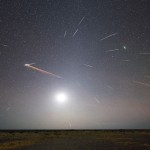
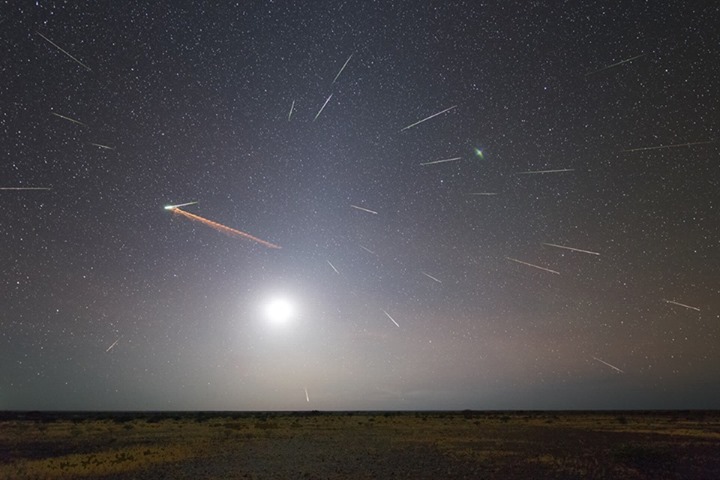
The 2013 Eta Aquariid meteor shower was fantastic as viewed from Earth’s Southern Hemisphere. Colin Legg of Australia created this composite of his experience. He wrote, “Composite of approximately 50 images containing 26 meteors, meteor train, 17% moon, zodiacal light and Pilbara desert.”
In 2019, the forecast calls for the greatest number of Eta Aquariid meteors to fall before dawn on (or near) May 5. However, this shower has a rather broad maximum, so the day before or after may be just as good. Fortunately, the new moon on May 4 will provide inky black skies for this year’s Eta Aquariid meteor shower. This shower favors the Southern Hemisphere, ranking as one of the finest showers of the year – in a year when no moon obscures the show. At mid-northern latitudes, these meteors don’t fall so abundantly – and the early morning twilight interferes at northerly latitudes.
Why more Eta Aquariid meteors in the Southern Hemisphere?
Halley’s Comet is the source of the Eta Aquariid meteor shower.
Enjoying EarthSky so far? Sign up for our free daily newsletter today!
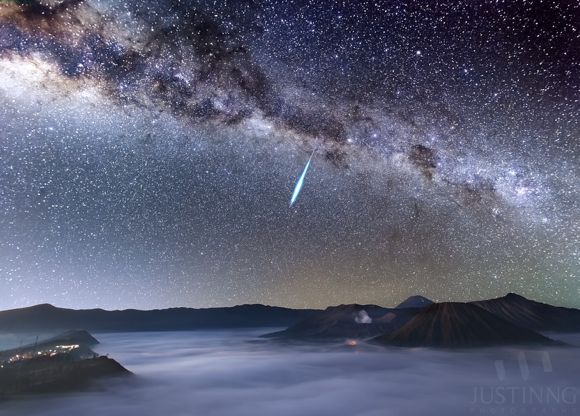
Meteor captured over Mount Bromo, an active volcano in Indonesia, during the 2013 Eta Aquariid shower. Photo by Justin Ng of Singapore. See more photos by Justin Ng.
When and how should I watch the Eta Aquariids? The 2019 Eta Aquariid meteor shower is expected to produce the greatest number of meteors in the wee hours before dawn on May 5. However, the broad peak of the Eta Aquariid shower may present a decent showing of meteors during the predawn hours on May 4 and May 6, too. And in fact the shower extends much beyond these dates on either side. Writing for the International Meteor Organization on May 1, 2017, Robert Lunsford pointed out:
… There is no sharp peak for this shower, but rather a plateau of good rates that last approximately one week centered on May 6.
In general, the best time to watch these fast and often bright meteors is in the early morning hours, before the onset of morning twilight. Don’t know when twilight begins in your part of the world? Try this link and remember to check the astronomical twilight box.
Give yourself at least an hour of viewing time for watching any meteor shower. Meteors tend to come in spurts that are interspersed by lulls. Also, it can take as long as 20 minutes for your eyes to adapt to the dark.
You need no special equipment to watch a meteor shower, but a little luck always helps. Meteor watching is a lot like fishing. Sometimes you catch a good number of them and sometimes you don’t.
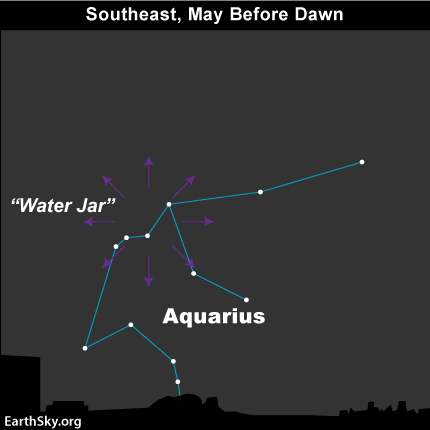
Radiant point of Eta Aquariid meteor shower. It’s in the constellation Aquarius, in the southeast before dawn on May mornings, as seen from mid-northern latitudes.
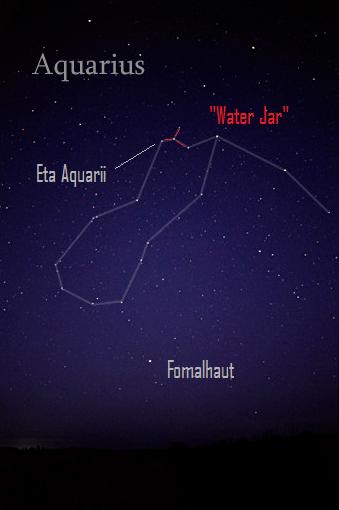
A Y-shaped asterism called the Water Jar marks the radiant of the Eta Aquariid meteor shower. It’s noticeable, if your sky is dark.
Radiant point of the Eta Aquariid shower. If you trace the paths of the Eta Aquariid meteors backward, they all seem to radiate from a certain point in front of the constellation Aquarius the Water Bearer. This point on the sky’s dome is called the radiant of the meteor shower, which nearly aligns with the faint star Eta Aquarii. Hence, this meteor shower is named in honor of this star.
Eta Aquarii is one of the four stars making up the Y-shaped Water Jar asterism in the northern part of Aquarius. If you can find the Water Jar in the constellation Aquarius, you’ve as good as located the radiant point for the Eta Aquariid meteors. The alignment of the radiant and the star is of course coincidental. Eta Aquarii is some 170 light-years away – trillons upon trillions of miles away – while the Eta Aquariid meteors burn up about 60 miles (100 km) above Earth’s surface.
Meteor shower radiants are sometimes misunderstood by casual meteor-watchers. You don’t need to know where they are to watch a meteor shower. That’s because the meteors fly every which way across the sky, in front of numerous constellations. However, the higher a shower’s radiant appears in your sky, the more meteors you’re likely to see. For the Eta Aquariids, the radiant soars highest in the nighttime sky just before dawn. That’s why you can expect to see the most meteors in the wee morning hours.
You can see some Eta Aquariid meteors in late evening, before the radiant rises into your sky. In fact, late evening is the best time to see earthgrazers, meteors that make exceptionally long streaks across your sky. As the radiant rises higher – that is, as the hours of the night tick away to dawn – you’ll see shorter meteors, but more meteors.
No special equipment is needed to watch a meteor shower. Find a dark, open sky away from artificial lights, and sprawl out on a reclining lawn chair.
How many meteors should I expect to see? In a dark sky, especially at more southerly latitudes, the Eta Aquariids can produce up to 20 to 40 meteors per hour. From mid-northern latitudes, you might only see about 10 meteors per hour.
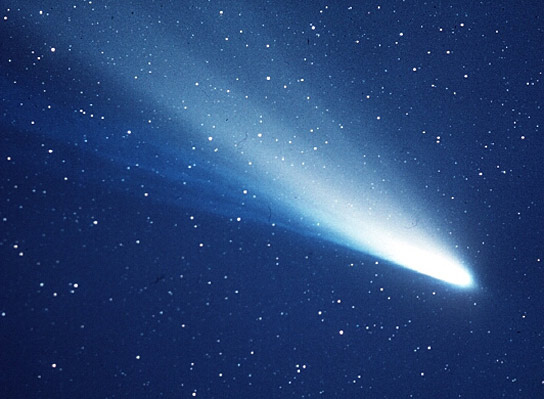
Halley’s Comet, the parent of the May Eta Aquariid and October Orionid meteor showers. Image vuia NASA Blueshift. Dust from this comet will streak the nighttime as Eta Aquariid meteors on the mornings of May 5 and 6.
Halley’s Comet is the source of the Eta Aquariid meteor shower. Every year, our planet Earth crosses the orbital path of Halley’s Comet in late April and May, so bits and pieces from this comet light up the nighttime as Eta Aquariid meteors. This shower is said to be active from April 19 to May 20, although Earth plows most deeply into this stream of comet debris around May 5 or 6.
The comet dust smashes into Earth’s upper atmosphere at nearly 150,000 miles per hour (240,000 kilometers per hour). Roughly half of these swift-moving meteors leave persistent trains – ionized gas trails that glow for a few seconds after the meteor has passed.
Our planet also crosses the orbital path of Halley’s Comet at the other end of the year, giving rise to the Orionid meteor shower, which is usually at its best in the predawn hours on or near October 21.
Bottom line: What’s a good meteor shower for the Southern Hemisphere? It’s usually the Eta Aquariid shower on the mornings of May 5 and 6. This year, 2019, the new moon on May 4 guarantees dark skies for this year’s presentation.
EarthSky’s meteor shower guide for 2019
from EarthSky http://bit.ly/1pRgiL8


The 2013 Eta Aquariid meteor shower was fantastic as viewed from Earth’s Southern Hemisphere. Colin Legg of Australia created this composite of his experience. He wrote, “Composite of approximately 50 images containing 26 meteors, meteor train, 17% moon, zodiacal light and Pilbara desert.”
In 2019, the forecast calls for the greatest number of Eta Aquariid meteors to fall before dawn on (or near) May 5. However, this shower has a rather broad maximum, so the day before or after may be just as good. Fortunately, the new moon on May 4 will provide inky black skies for this year’s Eta Aquariid meteor shower. This shower favors the Southern Hemisphere, ranking as one of the finest showers of the year – in a year when no moon obscures the show. At mid-northern latitudes, these meteors don’t fall so abundantly – and the early morning twilight interferes at northerly latitudes.
Why more Eta Aquariid meteors in the Southern Hemisphere?
Halley’s Comet is the source of the Eta Aquariid meteor shower.
Enjoying EarthSky so far? Sign up for our free daily newsletter today!

Meteor captured over Mount Bromo, an active volcano in Indonesia, during the 2013 Eta Aquariid shower. Photo by Justin Ng of Singapore. See more photos by Justin Ng.
When and how should I watch the Eta Aquariids? The 2019 Eta Aquariid meteor shower is expected to produce the greatest number of meteors in the wee hours before dawn on May 5. However, the broad peak of the Eta Aquariid shower may present a decent showing of meteors during the predawn hours on May 4 and May 6, too. And in fact the shower extends much beyond these dates on either side. Writing for the International Meteor Organization on May 1, 2017, Robert Lunsford pointed out:
… There is no sharp peak for this shower, but rather a plateau of good rates that last approximately one week centered on May 6.
In general, the best time to watch these fast and often bright meteors is in the early morning hours, before the onset of morning twilight. Don’t know when twilight begins in your part of the world? Try this link and remember to check the astronomical twilight box.
Give yourself at least an hour of viewing time for watching any meteor shower. Meteors tend to come in spurts that are interspersed by lulls. Also, it can take as long as 20 minutes for your eyes to adapt to the dark.
You need no special equipment to watch a meteor shower, but a little luck always helps. Meteor watching is a lot like fishing. Sometimes you catch a good number of them and sometimes you don’t.

Radiant point of Eta Aquariid meteor shower. It’s in the constellation Aquarius, in the southeast before dawn on May mornings, as seen from mid-northern latitudes.

A Y-shaped asterism called the Water Jar marks the radiant of the Eta Aquariid meteor shower. It’s noticeable, if your sky is dark.
Radiant point of the Eta Aquariid shower. If you trace the paths of the Eta Aquariid meteors backward, they all seem to radiate from a certain point in front of the constellation Aquarius the Water Bearer. This point on the sky’s dome is called the radiant of the meteor shower, which nearly aligns with the faint star Eta Aquarii. Hence, this meteor shower is named in honor of this star.
Eta Aquarii is one of the four stars making up the Y-shaped Water Jar asterism in the northern part of Aquarius. If you can find the Water Jar in the constellation Aquarius, you’ve as good as located the radiant point for the Eta Aquariid meteors. The alignment of the radiant and the star is of course coincidental. Eta Aquarii is some 170 light-years away – trillons upon trillions of miles away – while the Eta Aquariid meteors burn up about 60 miles (100 km) above Earth’s surface.
Meteor shower radiants are sometimes misunderstood by casual meteor-watchers. You don’t need to know where they are to watch a meteor shower. That’s because the meteors fly every which way across the sky, in front of numerous constellations. However, the higher a shower’s radiant appears in your sky, the more meteors you’re likely to see. For the Eta Aquariids, the radiant soars highest in the nighttime sky just before dawn. That’s why you can expect to see the most meteors in the wee morning hours.
You can see some Eta Aquariid meteors in late evening, before the radiant rises into your sky. In fact, late evening is the best time to see earthgrazers, meteors that make exceptionally long streaks across your sky. As the radiant rises higher – that is, as the hours of the night tick away to dawn – you’ll see shorter meteors, but more meteors.
No special equipment is needed to watch a meteor shower. Find a dark, open sky away from artificial lights, and sprawl out on a reclining lawn chair.
How many meteors should I expect to see? In a dark sky, especially at more southerly latitudes, the Eta Aquariids can produce up to 20 to 40 meteors per hour. From mid-northern latitudes, you might only see about 10 meteors per hour.

Halley’s Comet, the parent of the May Eta Aquariid and October Orionid meteor showers. Image vuia NASA Blueshift. Dust from this comet will streak the nighttime as Eta Aquariid meteors on the mornings of May 5 and 6.
Halley’s Comet is the source of the Eta Aquariid meteor shower. Every year, our planet Earth crosses the orbital path of Halley’s Comet in late April and May, so bits and pieces from this comet light up the nighttime as Eta Aquariid meteors. This shower is said to be active from April 19 to May 20, although Earth plows most deeply into this stream of comet debris around May 5 or 6.
The comet dust smashes into Earth’s upper atmosphere at nearly 150,000 miles per hour (240,000 kilometers per hour). Roughly half of these swift-moving meteors leave persistent trains – ionized gas trails that glow for a few seconds after the meteor has passed.
Our planet also crosses the orbital path of Halley’s Comet at the other end of the year, giving rise to the Orionid meteor shower, which is usually at its best in the predawn hours on or near October 21.
Bottom line: What’s a good meteor shower for the Southern Hemisphere? It’s usually the Eta Aquariid shower on the mornings of May 5 and 6. This year, 2019, the new moon on May 4 guarantees dark skies for this year’s presentation.
EarthSky’s meteor shower guide for 2019
from EarthSky http://bit.ly/1pRgiL8

Aucun commentaire:
Enregistrer un commentaire